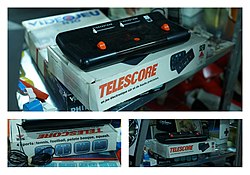
The Intellivision is a home video game console released by Mattel Electronics in 1979. It distinguished itself from competitors with more realistic sports and strategic games. By 1981, Mattel Electronics had close to 20% of the domestic video game market, selling more than 3.75 million consoles and 20 million cartridges through 1983. At its peak Mattel Electronics had about 1800 employees in several countries, including 110 videogame developers. In 1984, Mattel sold its video game assets to a former Mattel Electronics executive and investors, eventually becoming INTV Corporation. Game development ran from 1978 to 1990, when the Intellivision was discontinued.
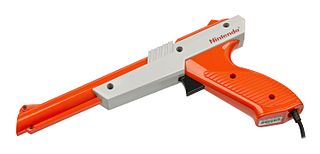
A light gun is a pointing device for computers and a control device for arcade and video games, typically shaped to resemble a pistol.
The PowerPC 7xx is a family of third generation 32-bit PowerPC microprocessors designed and manufactured by IBM and Motorola. This family is called the PowerPC G3 by Apple Computer, which introduced it on November 10, 1997. A number of microprocessors from different vendors have been used under the "PowerPC G3" name. Such designations were applied to Mac computers such as the PowerBook G3, the multicolored iMacs, iBooks and several desktops, including both the Beige and Blue and White Power Macintosh G3s. The low power requirements and small size made the processors ideal for laptops and the name lived out its last days at Apple in the iBook.
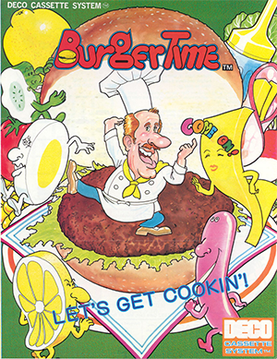
BurgerTime, originally released as Hamburger in Japan, is an arcade video game from Data East. It was published in 1982 for the DECO Cassette System. The player controls chef Peter Pepper who walks across oversized ingredients in a maze of platforms and ladders, causing them to fall and stack on buns below, eventually creating complete burgers. The chef is pursued by anthropomorphic hot dogs, fried eggs, and pickles. A limited supply of pepper can be thrown at aggressors immediately in front of Peter, briefly stunning them.

Scott Adams is an American entrepreneur, computer programmer, and video game designer. He co-founded, with then-wife Alexis, Adventure International in 1979. The company developed and published video games for home computers. The cornerstone products of Adventure International in its early years were the Adventure series of text adventures written by Adams.

In computer graphics, a sprite is a two-dimensional bitmap that is integrated into a larger scene, most often in a 2D video game. Originally, the term sprite referred to fixed-sized objects composited together, by hardware, with a background. Use of the term has since become more general.

Operation Wolf is a light gun shooter arcade game developed by Taito and released in 1987. It was ported to many home systems.
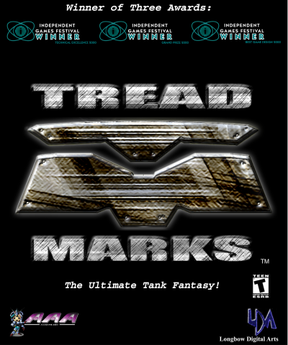
Tread Marks is a 3D, third-person perspective, multiplayer-focused tank combat and racing computer game developed by Independent video game developer Longbow Digital Arts. The game won the 2000 Independent Games Festival grand prize, later renamed to the Seumas McNally Grand Prize in honor of the game's lead programmer Seumas McNally who died on 21 March 2000, after receiving the award. A notable feature of the game is fully deformable terrain.
1977 had sequels such as Super Speed Race and Datsun 280 ZZZAP as well as several new titles such as Space Wars. The year's highest-grossing arcade games were F-1 and Speed Race DX in Japan, and Sea Wolf and Sprint 2 in the United States. The year's best-selling home system was Nintendo's Color TV-Game, which was only sold in Japan.

The GX4000 is a video game console that was manufactured by Amstrad. It was the company's short-lived attempt to enter the games console market. The console was released in Europe in 1990 and was an upgraded design based on the then still-popular CPC technology. The GX4000 shared hardware architecture with Amstrad's CPC Plus computer line, which was released concurrently. This allowed the system to be compatible with the majority of CPC Plus software.

SEB S.A. or better known as Groupe SEB is a large French consortium that produces small appliances, and it is the world's largest manufacturer of cookware. Notable brand names associated with Groupe SEB include All-Clad, IMUSA, Krups, Moulinex, Rowenta, Tefal, Mirro and WMF Group. According to the Groupe SEB website, they have faced considerable competition from low-price Chinese competitors, but have managed to maintain a constant sales level. A large proportion of their product lines are now manufactured in China. Its headquarters are in Ecully, a Lyon suburb.

Le Joueur du Grenier is the main character and title of a web television series of farcical retrogaming video reviews created by French filmmakers Frédéric Molas and Sébastien Rassiat in 2009, starring themselves. Similarly to the Angry Video Game Nerd, which is the direct inspiration for the show, it generally revolves around retro game reviews that involve rants against games of particularly low-quality or poor design.

Shoot Away is a 1977 electro-mechanical (EM) light gun shooter arcade game developed and published by Namco. Players use the shotgun-shaped light guns to fire at clay pigeons, represented as flying white dots on a projector screen. There are two that must be shot down in each round, and players only get two bullets to hit them. Bonus points are awarded for shooting the pigeons as soon as they appear, or by destroying both of them with a single bullet. The game was a critical and commercial success, maintaining a presence in arcades into the 1980s.

Arp 166 is a pair of interacting elliptical galaxies approximately 225 million light-years away from Earth in the constellation of Triangulum. The two galaxies, NGC 750 and NGC 751, are listed together as Arp 166 in the Atlas of Peculiar Galaxies.

NGC 750 is an elliptical galaxy approximately 225 million light-years away from Earth in the constellation of Triangulum. It forms a close pair of interacting galaxies together with the nearby NGC 751 galaxy. The pair is listed as Arp 166 in the Atlas of Peculiar Galaxies.

NGC 751 is an elliptical galaxy approximately 225 million light-years away from Earth in the constellation of Triangulum. It forms a close pair of interacting galaxies together with the nearby NGC 750 galaxy. The pair is listed as Arp 166 in the Atlas of Peculiar Galaxies.
The Philips Tele-Game series is a series of six dedicated first-generation home video game consoles manufactured, released and marketed between 1975 and 1978 by Dutch company Philips.
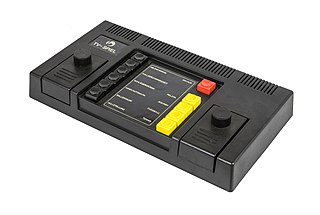
The Bildschirmspiel 01 is the only game console that was developed and manufactured in the German Democratic Republic (GDR). It is based on the integrated circuit AY-3-8500 by General Instrument. The gameplay, controls and audiovisual presentation of the four individually selectable games are similar to Pong. The BSS 01 was designed and produced by VEB Halbleiterwerk Frankfurt an der Oder (HFO). Its sales were started in 1979 under the RFT brand at a price of 550 East German marks. Due to a lack of profitability, production was discontinued after just two years. A successor device with more game options and additional colored image output did not pass the prototype stage.
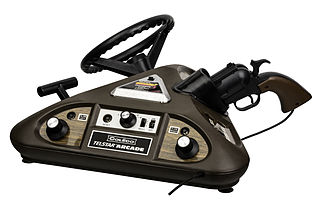
The Coleco Telstar Arcade, commonly abbreviated as Telstar Arcade, is a first-generation home video game console that was released in 1977 in Japan, North America and Europe by Coleco. It is the most advanced video game console in the Coleco Telstar series, based on the MOS Technology MPS-7600-00x chips series. Each chip is a microcontroller capable of storing 512 words of ROM.
Hector are a series of a microcomputers produced in France in the early 1980s.
